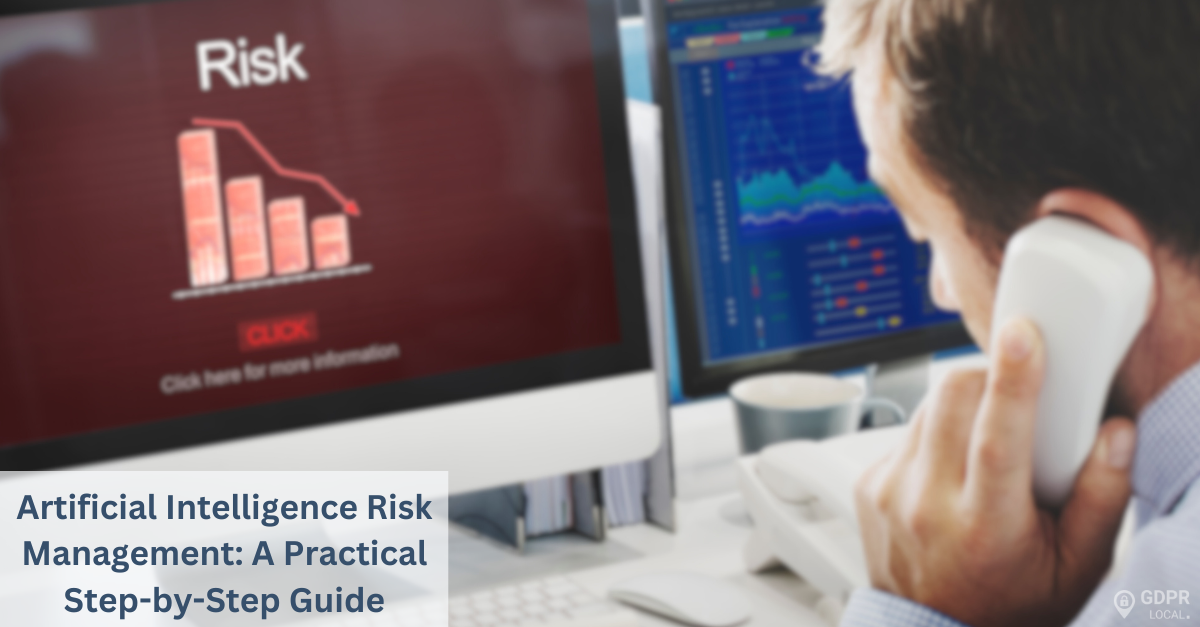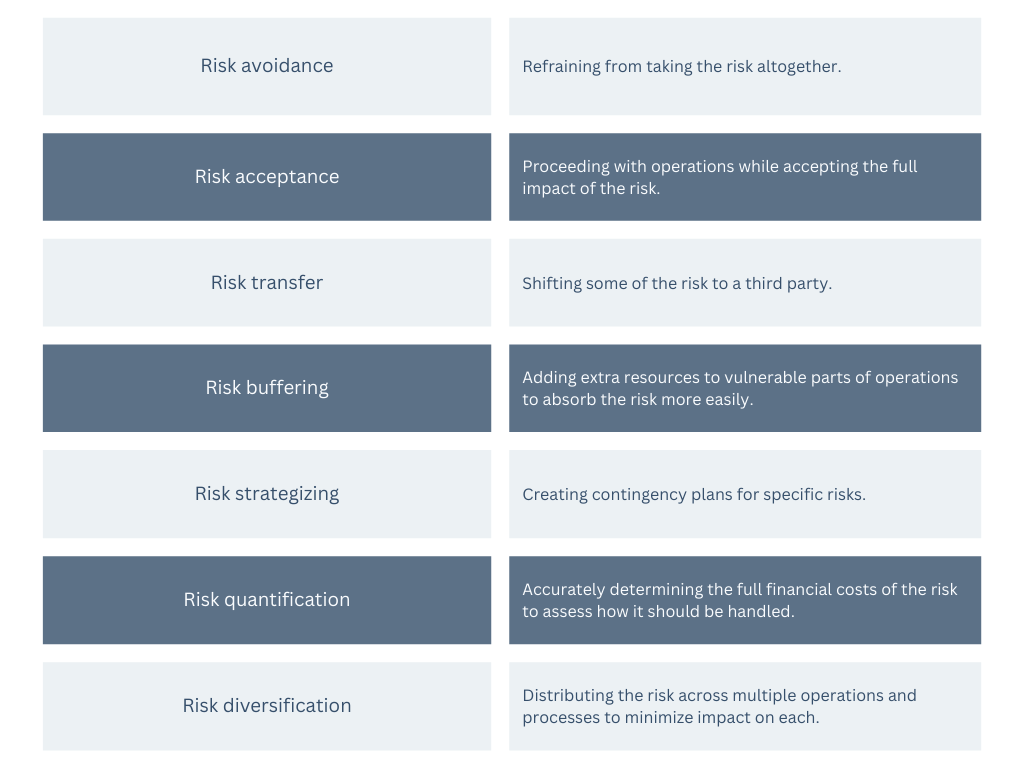
Artificial Intelligence Risk Management: A Practical Step-by-Step Guide
We’re living in an era where artificial intelligence is transforming industries at breakneck speed. Artificial intelligence risk management has become a top priority for organizations aiming to harness AI’s potential while safeguarding their operations, reputation, and compliance with regulations like GDPR.
In this guide, we will take you through the key steps to performing an AI risk assessment and establishing a strong risk management framework.
Understanding AI Risks in Business
As artificial intelligence continues to transform industries, it’s crucial for organizations to grasp the potential risks associated with AI implementation.
Types of AI Risks
AI risks can be categorized into several key areas.
One of the most significant concerns is cybersecurity. AI systems, despite their efficiencies, are exposed to vulnerabilities and susceptible to hacking, cyberattacks, and security breaches. These threats extend beyond data theft to include adversarial attacks—technical faults that inject unpredictability into AI models.
Another critical risk is bias and discrimination. AI systems can inadvertently perpetuate or amplify societal biases due to biased training data or algorithmic design. This can lead to unfair outcomes and decision-making processes, potentially harming individuals or groups.
Privacy is also a major concern in AI risk management. AI technologies often collect and analyze large amounts of personal data, raising issues related to data privacy and security. This is particularly relevant in the context of GDPR compliance, which mandates strict data protection measures.
Ethical dilemmas pose another significant challenge. Instilling moral and ethical values in AI systems, especially in decision-making contexts with significant consequences, is a complex task that requires careful consideration.
Impact on Organizations
The impact of AI risks on organizations can be substantial. Reputational damage is a primary concern, with 75% of Chief Risk Officers (CROs) surveyed stating that the use of AI poses a reputational risk to their organization. This highlights the need for robust AI governance frameworks to mitigate potential negative outcomes.
AI can also have significant financial implications. Implementing AI technologies often requires substantial investment in infrastructure, talent, and ongoing maintenance. Moreover, the computational cost for training data models can be an additional expense that organizations need to factor into their budgets.
Job displacement is another potential impact of AI adoption. While there’s evidence that AI and other emerging technologies will create more jobs than they eliminate, the transition period can be challenging for organizations and employees alike. This necessitates a focus on reskilling and upskilling programs to ensure workforce adaptability.
Regulatory Landscape
The regulatory landscape surrounding AI is rapidly evolving. Nine out of ten CROs believe more needs to be done to regulate the development and use of AI. This sentiment reflects the growing recognition of AI’s potential risks and the need for comprehensive governance frameworks.
The European Union has taken a leading role in AI regulation with the introduction of the EU AI Act. This legislation takes a risk-based approach, categorizing AI systems into different risk levels: unacceptable, high, limited, and minimal risk. Each category has specific regulations and requirements for organizations developing or using AI systems.
In the United States, President Biden issued an Executive Order on Safe, Secure, and Trustworthy Artificial Intelligence, which expands the mandate of federal agencies in relation to AI best practices and safeguards. This reflects a growing global trend towards more stringent AI governance.
As the regulatory landscape continues to evolve, organizations must stay informed and adapt their AI risk management strategies accordingly. This includes conducting regular AI risk assessments, implementing secure data collection practices, and ensuring compliance with relevant regulations such as GDPR.
Steps to Conduct an AI Risk Assessment
Conducting an artificial intelligence risk assessment is crucial for organizations to identify and mitigate potential risks associated with AI implementation. We’ll walk you through the essential steps to ensure a comprehensive evaluation of your AI systems.
Identify AI Systems and Use Cases
The first step in our AI risk assessment process is to identify the AI systems and use cases within our organization. We need to describe each AI use case in detail, specifying the business problem being solved, listing all relevant stakeholders, and characterizing the workflow. It’s important to provide details regarding key inputs and outputs of the system.
We should consider how users interact with the AI system to achieve particular goals. This step helps us understand the scope and impact of our AI implementations across different departments and processes.
Analyze Potential Risks
Once we’ve identified our AI systems and use cases, we move on to analyzing potential risks. We need to consider various dimensions of responsible AI, such as fairness, robustness, and privacy. It’s crucial to reflect on how different stakeholders might be affected along these dimensions.
To conduct a thorough analysis, we can employ several techniques:
Bow-tie analysis | Dividing each risk into contributing factors and consequences, then listing mitigation strategies for the core risk. |
| Delphi method | Brainstorming with experts to create a comprehensive list of all potential risks. |
| SWIFT analysis | Gathering in team meetings to pose “what-if” questions (Structured What-IF Technique). |
| Decision-tree analysis | Plotting out all possible outcomes as a risk scenario evolves. |
These methods help us identify a wide range of potential risks, from data privacy concerns to biases in AI decision-making processes.
Evaluate Risk Severity and Likelihood
After identifying potential risks, we need to evaluate their severity and likelihood. We can use a combination of likelihood and severity scales to measure the probability of occurrence and the degree of consequences for each risk.
A helpful starting point is to use qualitative non-numerical categories ranging from very low to very high risk, or semi-quantitative assessments such as scales from 1 to 10. We can then use a risk matrix scheme to quantify the overall risk for each stakeholder along relevant dimensions.
For example, we might consider an event with low severity and rare likelihood of occurring as very low risk. It’s important to note that this initial assessment estimates inherent risk, and we’ll need to consider risk mitigation strategies to lower risk levels further.
Develop Mitigation Strategies
The final step in our AI risk assessment process is to develop mitigation strategies for the identified risks. We need to prioritize risks based on their severity and likelihood, focusing our resources on those that pose the greatest threat to our organization and stakeholders.
Some risk mitigation strategies we can consider include:

It’s crucial to involve our legal, risk management, and data science teams in developing these mitigation strategies. By putting these teams at the center of our AI development process, we ensure that our models conform to social norms and legal requirements while still delivering maximum business value.
This process is essential for responsible AI governance and ensures that we’re prepared to handle the challenges that come with implementing artificial intelligence in our organization.
Implementing an AI Risk Management Framework
Implementing an effective artificial intelligence risk management framework is crucial for organizations to harness the power of AI while mitigating potential risks. We’ll explore the key components, best practices, and challenges associated with implementing such a framework.
Key Components
A good AI risk management framework consists of several essential elements. First, we need to establish a comprehensive governance structure that oversees AI development and deployment. This involves creating clear lines of responsibility and accountability within the organization.
Next, we must integrate AI risk assessments into our existing risk management methodologies. This process should involve stakeholders from various departments, including compliance, IT, legal, and HR, to ensure a holistic approach to identifying and evaluating AI-related risks.
Another critical component is the development of AI-specific policies. These policies should define acceptable use of AI tools, explain our approach to ethical AI implementation, and outline practices for data collection and management that comply with regulations like GDPR.
Best Practices
To implement an effective AI risk management framework, we should follow several best practices. One key practice is to conduct regular AI risk assessments. These assessments help us identify potential risks related to privacy, security, fairness, and transparency in our AI systems.
We also need to properly evaluate third-party AI tools. This involves reviewing the vendor’s privacy policy and security posture, understanding how our data might be used, and obtaining attestations verifying the tool’s security has been assessed by qualified third parties.
Continuous monitoring is another crucial best practice. We should implement real-time monitoring tools that can detect anomalies, performance degradation, or unexpected behaviors in our AI systems. This allows us to address issues proactively before they escalate into significant problems.
Training and awareness programs are essential for fostering a culture of responsible AI use. We should develop ongoing training initiatives to keep employees informed about AI risks and how to manage them effectively.
Challenges and Solutions
Implementing an AI risk management framework comes with its share of challenges. One significant challenge is quantifying AI risks due to their often abstract nature. To address this, we can utilize AI-specific risk assessment frameworks and conduct scenario analyzes to better understand how AI risks might manifest in real-world situations.
Another challenge is keeping pace with rapidly evolving AI technologies and regulations. To overcome this, we need to establish agile processes for reviewing and updating our AI risk management strategies regularly. Implementing feedback mechanisms to learn from incidents and near-misses involving AI can also help us stay ahead of emerging risks.
Balancing innovation with risk management can be tricky. We don’t want our framework to stifle creativity and progress. To strike the right balance, we should focus on creating flexible guidelines that promote responsible AI development while allowing room for innovation.
Lastly, ensuring transparency and explainability in AI systems can be challenging, especially with complex models. To address this, we can utilize explainable AI (XAI) tools to increase model interpretability and implement robust documentation practices throughout the AI lifecycle.
By addressing these challenges and implementing a comprehensive AI risk management framework, we can navigate the complexities of AI implementation more effectively. This approach not only helps us mitigate potential risks but also positions us to leverage AI’s full potential responsibly and ethically.
Conclusion
To wrap up, artificial intelligence risk management is crucial for organizations aiming to harness AI’s potential while safeguarding their operations.
A well-structured approach to AI risk management not only helps minimize potential pitfalls but also positions companies to leverage AI’s full potential responsibly and ethically. As AI continues to shape industries, proactive risk management will be key to ensuring its safe and beneficial integration into business operations.
FAQs
How can artificial intelligence be utilized in managing risks?
Artificial intelligence can be employed in risk management through the detection and assessment of risks. AI systems are capable of analyzing varied unstructured data sources to pinpoint risks that might be overlooked by human analysts. These systems use machine learning and natural language processing to identify patterns signaling potential risks.
What constitutes an AI risk management framework?
An AI risk management framework comprises a collection of guidelines and best practices designed to aid organizations in managing the risks linked with artificial intelligence systems. This framework offers a systematic method for identifying, assessing, and mitigating risks throughout the AI system’s lifecycle.
What is the purpose of the Defense AI Guide on risk?
The Defense AI Guide on Risk (DAGR) primarily serves to outline relevant Responsible AI (RAI) concepts, guide holistic risk evaluations, and provide a simplified risk model. This model helps in mitigating the risks of AI capabilities while fostering responsibility and trust.
Is it possible for AI to completely take over risk management?
While AI and machine learning (ML) have significantly enhanced the efficiency and productivity of risk management by reducing costs, they have not completely taken over the field. AI’s ability to swiftly process and analyze large volumes of unstructured data with minimal human intervention has transformed many aspects of risk management, but human oversight remains crucial.